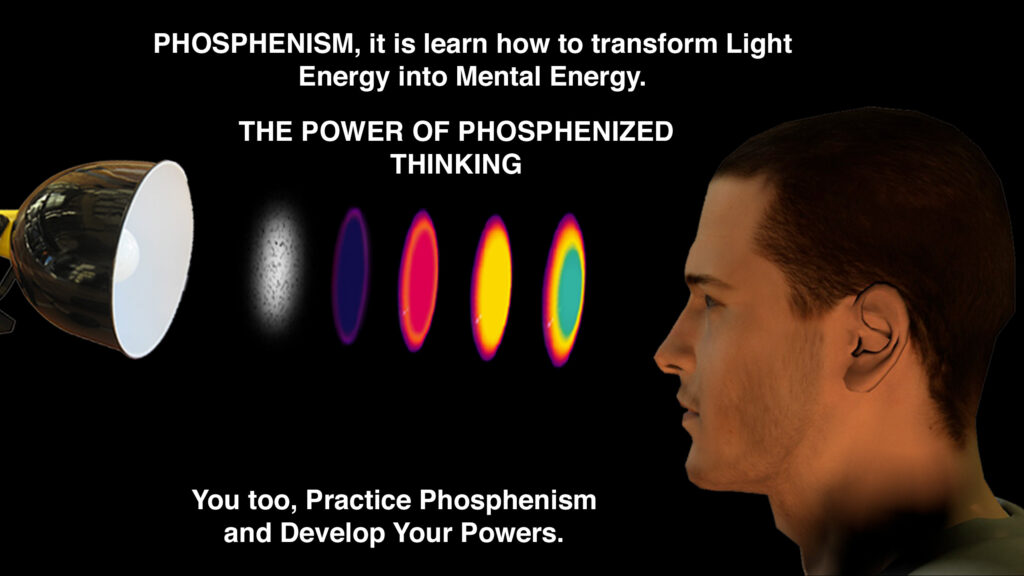AURA PERCEPTION

The aura, the third phase of the phosphene
You do not have to practice Phosphenism to observe colors in your field of vision. In the dark, laying on your bed with your eyes closed, relax and observe your field of vision. Generally, after half an hour a glow starts to appear followed by clouds of colors: blue, pink, yellow or purple. Dr Lefebure calls these patches of light the diffuse glow.
In order to observe this phenomenon, certain tibetan lamas remain in an entirely dark room for months, or even years… The purpose of this practice is to perceive a light that is neither physical nor imaginary: a spiritual light.
Alexandra David-Neel reports that meditating in the dark is a common practice in India and in most Buddhist countries.
Thanks the works of Doctor Lefebure, it is not necessary to spend that much time practicing in such a way if one understands well all the phases of the phosphene. The visual perception that persists in the dark when you close your eyes is called visual chaos. Nevertheless, persons who practice Phosphenism regularly develop a much denser visual chaos that they can perceive with their eyes open. It is thus possible to project your visual chaos over your perception of the material world. The two perceptions react together, bringing interesting information.
Practicing Phosphenism develops intuition. The brain, like a radar, emits a wave: this wave is reflected on the object of study and comes back carrying information. The principle of the radar lays on the localization of objects by the means of the echo. This is how bats and dolphins understand the world. It is thus not surprising to find that this principle of perception in humans. Seeing auras follows the same mechanism. It consists in projecting one’s visual chaos on an object or a person, producing an echo in the form of a phenomenon of clairvoyance.
Is it possible to take photographs of the aura?
KIRLIAN photography does not belong to the domain of initiatory research, as the KIRLIAN effect is limited to the measurement of electromagnetic force fields. The only interest of KIRLIAN photography is therapeutic.
The aura, as described by occultists, is merely the third phase of the phosphene: the diffuse glow. The elements thus perceived in one’s field of vision can be interpreted and can trigger clairvoyance phenomena. Like cards or any other medium, the diffuse glow produces intuitions or flashes if one concentrates on it.
The actual AURA can only be perceived during out of body experiences. This form of perception is nevertheless quite rare.
The various layers of the aura and the visual chaos
First layer: the brightest (dense diffuse glow), is also called the etheric body
Second layer: a grayish layer (diffuse glow) which is also called astral body
Third layer: the perception and organization of the visual chaos, also called mental body
Understanding and seeing the aura
The aura that we can perceive around a person is created by our brain. It is the third phase of the phosphene, called ‟diffuse glow” that is superimposed over the image of the subject we observe.
Preliminary exercise:
You are going to practice chasing for details in the visual chaos during 45 minutes.
In order to do this, switch the light off and place yourself comfortably in an armchair or lay on your bed; place an eye patch over your eyes.
Close your eyes and observe your field of vision.
After a while you will notice that your field of vision is not totally dark and that, on the countrary, many dots of light and colors appear within it. Concentrate on the smaller details that appear, after 10 to 15 minutes of concentration, patches of brightness appear. Keep concentrating on the details that appear within this glow. Sooner or later, you might be surprised by the appearance of a small, very precise image: a vision.
Aura perception exercise
Ask a person to stand in front of a white wall. Focus on an imaginary point located 3 to 4 cm above the top of their head. Relax and try not to move your eyes.
You will start perceiving a glow around the subject. This glow does not have the same intensity if you ask the subject to concentrate on their feet or on their head. You will observe that the aura has a maximum of intensity when you ask the subject to pray or to think very strongly that God is located just above them.
Certain persons also perceive colors around the subject; they can also see images or scenes related to that person’s life (organization of the visual chaos).
As a counter experiment, observe the aura of an object. Choose a circular object, as its aura is easier to perceive by a beginner. You will notice that of the aura of an object appears in a uniform manner and that its intensity does not change when the aura of a person varies depending on the nature of their thoughts.
Importante Note
We have done our best to provide you with the most accurate translation of our french website. Nevertheless, it is possible that some language errors may remain. So, don’t hesitate to contact us to communicate them to us.
Thank you for your indulgence and for your consideration of the many hours spent translating all our pages and, more particularly, all the testimonies we share with you so that you may become aware of the impact that Phosphenism can have on those who practice it.
Wishing you the best with your practice of Phosphenism.
Daniel Stiennon (Dr. LEFEBURE School Director, France)


